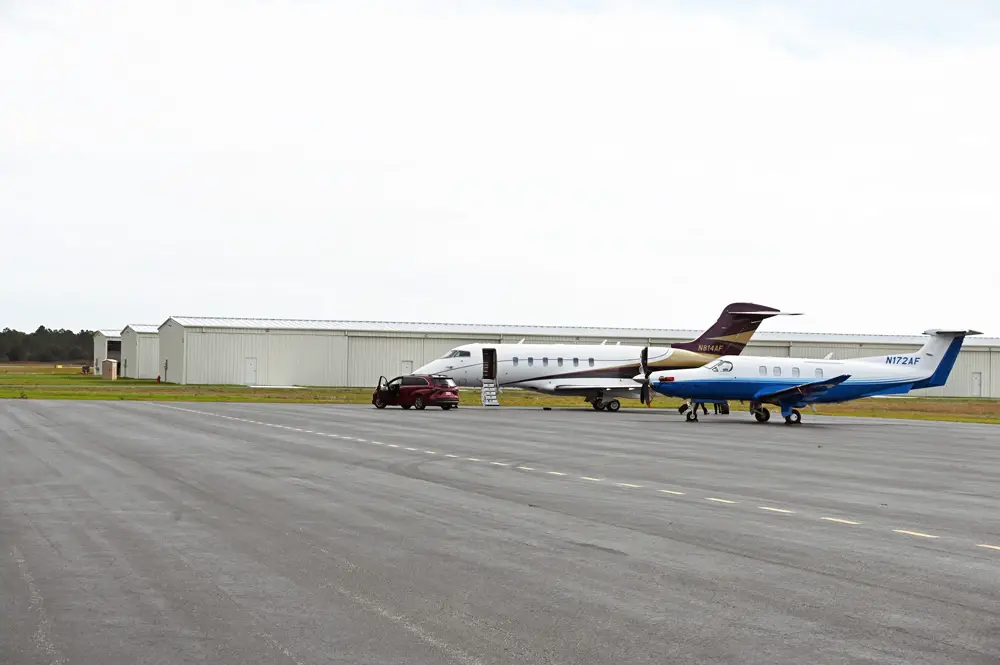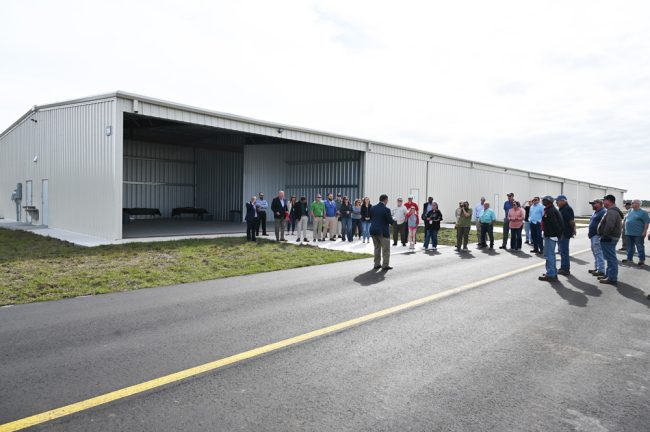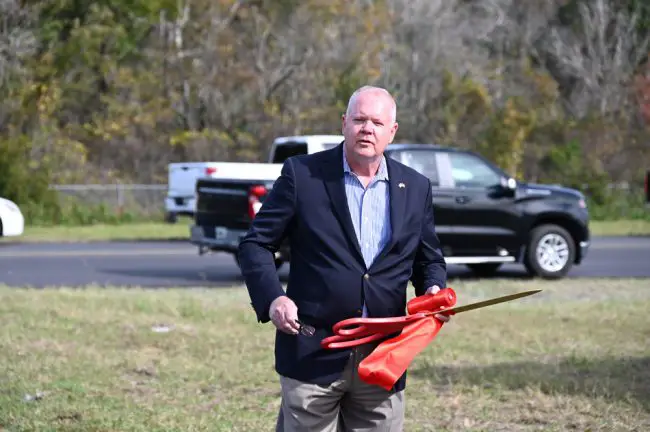
No sooner built than filled: The 42 T-hangar units in three buildings just built for $6.5 million and not yet occupied at Flagler Executive Airport are already all leased, with a waiting list for hangar space again stretching to close to 160 people. Airport Director Roy Sieger and county officials don’t mind: that kind of numbers means the airport business in good shape, Flagler County is in demand, and the spur to another T-hangar project speaks for itself.
“I’ll be talking to my FDOT people–they don’t want to hear it yet,” Sieger told a few dozen people assembled for a ribbon-cutting at one of the hangars late this morning, referring to the Florida Department of Transportation, which financed 90 percent of the project. “We have room to build three more rows just like this on the other side here,” he said, pointing to the east side of the airport grounds, “so we still have a lot ore room to grow, and once we fill this up, we can move back there, there’s plenty of room back there too,” at the south end of the grounds.
The 1,300-acre airport has 130 acres of developable property, 75 acres of that aviation-related. It already had 56 T-hangars, nine box hangars and 50 tie-down spaces outside of hangars.
Planes will move into the new hangars probably in January. The ribbon-cutting was anchored by County Commissioner Andy Dance, with Commissioners Dave Sullivan and Don O’Brien in attendance. “We want to thank the FAA and FDOT for their support,” Dance said. “As you can see with their support we’ve been able to grow and add needed facilities.”
Most of the planes that will fill the hangs–and that fill existing hangars–are owned by “average Joes” who like to fly, mostly for leisure, Seiger said. They are primarily single-engine aircraft, though some units can hold plans with wing spans of 45 feet, like the Cessna 310. Typically, planes in the hangars will have wing spans of 36 to 45 feet.
The hangars currently rent for from $400 to $675 a month. A cost increase, based on a rate study by Cooksey and Associates, is to be approved by the County Commission next Monday, averaging $50 a month. Once fully rented, they’ll bring $257,400 a year to the airport fund. As a Fixed Based Operation (or FBO), the airport has the right to operate the hangars and sell fuel, so those fuel sales from planes parked in the new hangars will generate an additional $40,000 to $50,000 a year, Sieger estimates. Last year’s adopted budget projected fuel sales–for both aviation and jet fuel–of $1.3 million. The projection this year is for sales of $1.4 million.
The airport is a so-called “enterprise fund,” which means that while it’s county-owned and run by the county, it operates separately from the general fund, as its own business, on a $3.2 million budget this year. T-hangar rent in 2022 was $217,000. This year, that’s expected to go up to $377,670, and go up further next year, when rent payments will stretch over the full year. The airport rents other spaces, too, generating additional revenue of $1 million.
S.E. Cline was the general contractor on the project, with MM Development building the metal hangars. Both are local businesses, as is Halifax Paving. The project included the rahabilitation of one of the airport’s taxiways. “When we build things like this, it helps. That’s what helps generate this local economy as well. These are all local businesses and all these local businesses are also benefiting from doing these properties in the airport,” Sieger said.
Next on the list of projects at the airport is the groundbreaking for the new terminal to be built there, possibly next summer, if funding is secured by then.
![]()












